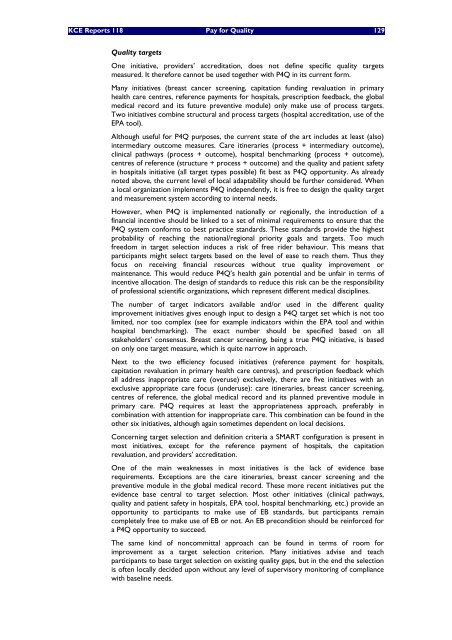Pay for Quality
Pay for Quality
Pay for Quality
Create successful ePaper yourself
Turn your PDF publications into a flip-book with our unique Google optimized e-Paper software.
KCE Reports 118 <strong>Pay</strong> <strong>for</strong> <strong>Quality</strong> 129<br />
<strong>Quality</strong> targets<br />
One initiative, providers’ accreditation, does not define specific quality targets<br />
measured. It there<strong>for</strong>e cannot be used together with P4Q in its current <strong>for</strong>m.<br />
Many initiatives (breast cancer screening, capitation funding revaluation in primary<br />
health care centres, reference payments <strong>for</strong> hospitals, prescription feedback, the global<br />
medical record and its future preventive module) only make use of process targets.<br />
Two initiatives combine structural and process targets (hospital accreditation, use of the<br />
EPA tool).<br />
Although useful <strong>for</strong> P4Q purposes, the current state of the art includes at least (also)<br />
intermediary outcome measures. Care itineraries (process + intermediary outcome),<br />
clinical pathways (process + outcome), hospital benchmarking (process + outcome),<br />
centres of reference (structure + process + outcome) and the quality and patient safety<br />
in hospitals initiative (all target types possible) fit best as P4Q opportunity. As already<br />
noted above, the current level of local adaptability should be further considered. When<br />
a local organization implements P4Q independently, it is free to design the quality target<br />
and measurement system according to internal needs.<br />
However, when P4Q is implemented nationally or regionally, the introduction of a<br />
financial incentive should be linked to a set of minimal requirements to ensure that the<br />
P4Q system con<strong>for</strong>ms to best practice standards. These standards provide the highest<br />
probability of reaching the national/regional priority goals and targets. Too much<br />
freedom in target selection induces a risk of free rider behaviour. This means that<br />
participants might select targets based on the level of ease to reach them. Thus they<br />
focus on receiving financial resources without true quality improvement or<br />
maintenance. This would reduce P4Q’s health gain potential and be unfair in terms of<br />
incentive allocation. The design of standards to reduce this risk can be the responsibility<br />
of professional scientific organizations, which represent different medical disciplines.<br />
The number of target indicators available and/or used in the different quality<br />
improvement initiatives gives enough input to design a P4Q target set which is not too<br />
limited, nor too complex (see <strong>for</strong> example indicators within the EPA tool and within<br />
hospital benchmarking). The exact number should be specified based on all<br />
stakeholders’ consensus. Breast cancer screening, being a true P4Q initiative, is based<br />
on only one target measure, which is quite narrow in approach.<br />
Next to the two efficiency focused initiatives (reference payment <strong>for</strong> hospitals,<br />
capitation revaluation in primary health care centres), and prescription feedback which<br />
all address inappropriate care (overuse) exclusively, there are five initiatives with an<br />
exclusive appropriate care focus (underuse): care itineraries, breast cancer screening,<br />
centres of reference, the global medical record and its planned preventive module in<br />
primary care. P4Q requires at least the appropriateness approach, preferably in<br />
combination with attention <strong>for</strong> inappropriate care. This combination can be found in the<br />
other six initiatives, although again sometimes dependent on local decisions.<br />
Concerning target selection and definition criteria a SMART configuration is present in<br />
most initiatives, except <strong>for</strong> the reference payment of hospitals, the capitation<br />
revaluation, and providers’ accreditation.<br />
One of the main weaknesses in most initiatives is the lack of evidence base<br />
requirements. Exceptions are the care itineraries, breast cancer screening and the<br />
preventive module in the global medical record. These more recent initiatives put the<br />
evidence base central to target selection. Most other initiatives (clinical pathways,<br />
quality and patient safety in hospitals, EPA tool, hospital benchmarking, etc.) provide an<br />
opportunity to participants to make use of EB standards, but participants remain<br />
completely free to make use of EB or not. An EB precondition should be rein<strong>for</strong>ced <strong>for</strong><br />
a P4Q opportunity to succeed.<br />
The same kind of noncommittal approach can be found in terms of room <strong>for</strong><br />
improvement as a target selection criterion. Many initiatives advise and teach<br />
participants to base target selection on existing quality gaps, but in the end the selection<br />
is often locally decided upon without any level of supervisory monitoring of compliance<br />
with baseline needs.
















